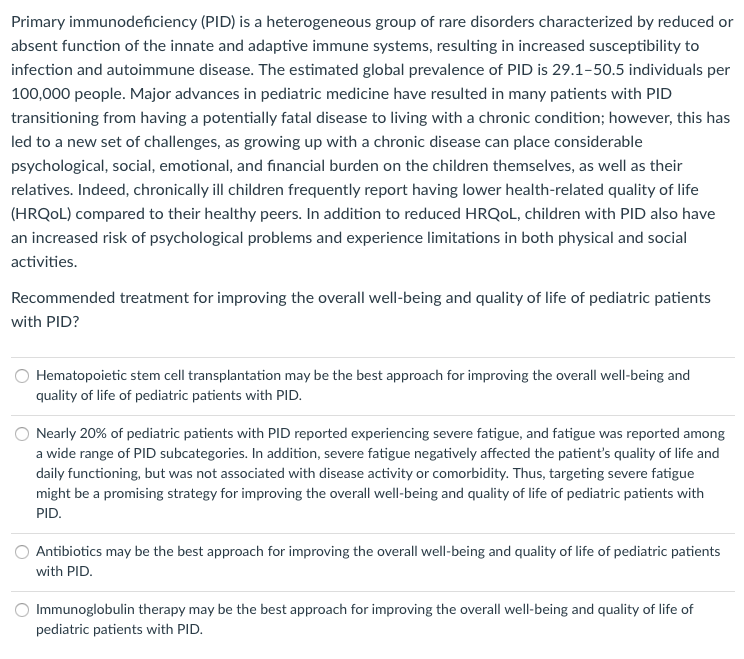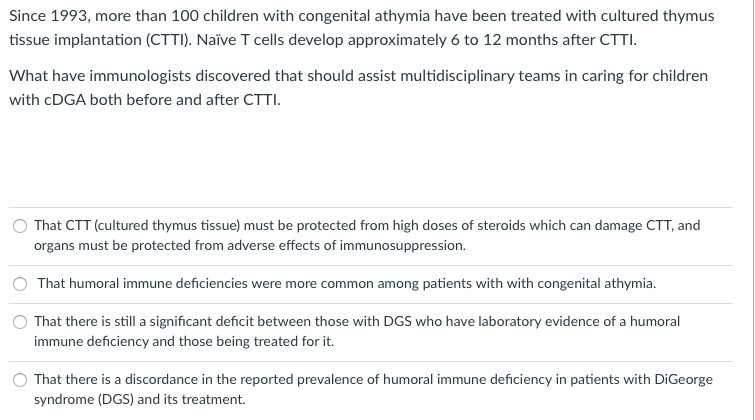Primary immunodeficiency (PID) is a heterogeneous group of rare disorders characterized by reduced or absent function of the innate and adaptive immune systems, resulting in increased susceptibility to infection and autoimmune disease. The estimated global prevalence of PID is 29.1-50.5 individuals per 100,000 people. Major advances in pediatric medicine have resulted in many patients with PID transitioning from having a potentially fatal disease to living with a chronic condition; however, this has led to a new set of challenges, as growing up with a chronic disease can place considerable psychological, social, emotional, and financial burden on the children themselves, as well as their relatives. Indeed, chronically ill children frequently report having lower health-related quality of life (HRQOL) compared to their healthy peers. In addition to reduced HRQOL, children with PID also have an increased risk of psychological problems and experience limitations in both physical and social activities. Recommended treatment for improving the overall well-being and quality of life of pediatric patients with PID?
Primary immunodeficiency (PID) is a heterogeneous group of rare disorders characterized by reduced or absent function of the innate and adaptive immune systems, resulting in increased susceptibility to infection and autoimmune disease. The estimated global prevalence of PID is 29.1-50.5 individuals per 100,000 people. Major advances in pediatric medicine have resulted in many patients with PID transitioning from having a potentially fatal disease to living with a chronic condition; however, this has led to a new set of challenges, as growing up with a chronic disease can place considerable psychological, social, emotional, and financial burden on the children themselves, as well as their relatives. Indeed, chronically ill children frequently report having lower health-related quality of life (HRQOL) compared to their healthy peers. In addition to reduced HRQOL, children with PID also have an increased risk of psychological problems and experience limitations in both physical and social activities. Recommended treatment for improving the overall well-being and quality of life of pediatric patients with PID?
Human Heredity: Principles and Issues (MindTap Course List)
11th Edition
ISBN:9781305251052
Author:Michael Cummings
Publisher:Michael Cummings
Chapter17: Genes And The Immune System
Section: Chapter Questions
Problem 23QP: Organ Transplants Must Be Immunologically In the human HLA system there are 23 HLA-A alleles, 47 for...
Related questions
Question

Transcribed Image Text:Primary immunodeficiency (PID) is a heterogeneous group of rare disorders characterized by reduced or
absent function of the innate and adaptive immune systems, resulting in increased susceptibility to
infection and autoimmune disease. The estimated global prevalence of PID is 29.1-50.5 individuals per
100,000 people. Major advances in pediatric medicine have resulted in many patients with PID
transitioning from having a potentially fatal disease to living with a chronic condition; however, this has
led to a new set of challenges, as growing up with a chronic disease can place considerable
psychological, social, emotional, and financial burden on the children themselves, as well as their
relatives. Indeed, chronically ill children frequently report having lower health-related quality of life
(HRQOL) compared to their healthy peers. In addition to reduced HRQOL, children with PID also have
an increased risk of psychological problems and experience limitations in both physical and social
activities.
Recommended treatment for improving the overall well-being and quality of life of pediatric patients
with PID?
Hematopoietic stem cell transplantation may be the best approach for improving the overall well-being and
quality of life of pediatric patients with PID.
O Nearly 20% of pediatric patients with PID reported experiencing severe fatigue, and fatigue was reported among
a wide range of PID subcategories. In addition, severe fatigue negatively affected the patient's quality of life and
daily functioning, but was not associated with disease activity or comorbidity. Thus, targeting severe fatigue
might be a promising strategy for improving the overall well-being and quality of life of pediatric patients with
PID.
Antibiotics may be the best approach for improving the overall well-being and quality of life of pediatric patients
with PID.
Immunoglobulin therapy may be the best approach for improving the overall well-being and quality of life of
pediatric patients with PID.

Transcribed Image Text:Since 1993, more than 100 children with congenital athymia have been treated with cultured thymus
tissue implantation (CTTI). Naïve T cells develop approximately 6 to 12 months after CTTI.
What have immunologists discovered that should assist multidisciplinary teams in caring for children
with CDGA both before and after CTTI.
That CTT (cultured thymus tissue) must be protected from high doses of steroids which can damage CTT, and
organs must be protected from adverse effects of immunosuppression.
That humoral immune deficiencies were more common among patients with with congenital athymia.
That there is still a significant deficit between those with DGS who have laboratory evidence of a humoral
immune deficiency and those being treated for it.
That there is a discordance in the reported prevalence of humoral immune deficiency in patients with DiGeorge
syndrome (DGS) and its treatment.
Expert Solution
This question has been solved!
Explore an expertly crafted, step-by-step solution for a thorough understanding of key concepts.
This is a popular solution!
Trending now
This is a popular solution!
Step by step
Solved in 2 steps

Recommended textbooks for you

Human Heredity: Principles and Issues (MindTap Co…
Biology
ISBN:
9781305251052
Author:
Michael Cummings
Publisher:
Cengage Learning

Human Heredity: Principles and Issues (MindTap Co…
Biology
ISBN:
9781305251052
Author:
Michael Cummings
Publisher:
Cengage Learning